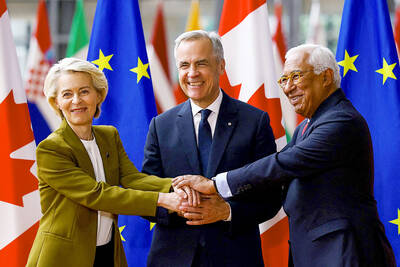Two circulating beams on Monday produced the first particle collisions in the world’s biggest atom smasher, the Large Hadron Collider (LHC), three days after its restart, scientists said.
In a statement, the European Organization for Nuclear Research (CERN) said two beams circulating simultaneously led to collisions at all four detection points during the afternoon and evening.
“It’s a great achievement to have come this far in so short a time,” CERN director general Rolf Heuer said. “But we need to keep a sense of perspective. There’s still much to do before we can start the LHC physics program.”
CERN had said earlier on Monday the relaunch of the 3.9 billion euro (US$5 billion) collider was “an enormous success” after it was out of action for 14 months because of a serious electrical fault.
Scientists are looking to the collider — inside a 27km tunnel straddling the Franco-Swiss border — to mimic the conditions that followed the Big Bang and help explain the origins of the universe.
“Today the LHC circulated two beams simultaneously for the first time, allowing the operators to test the synchronization of the beams and giving the experiments their first chance to look for proton-proton collisions,” CERN said in its statement. “With just one bunch of particles circulating in each direction, the beams can be made to cross in up to two places in the ring.”
The first collision was picked up at 2:44pm by the Atlas detector beneath the Swiss town of Meyrin, one of several laid out along the route of the world’s most powerful physics experiment.
Smash-ups then followed at the three other detectors, known as CMS, Alice and LHCb.
“It was standing-room-only in the Alice control room and cheers erupted with the first collisions,” Alice spokesperson Jurgen Schukraft said. “This is simply tremendous.”
“The tracks we’re seeing are beautiful,” the CERN statement quoted LHCb spokesperson Andrei Golutvin as saying. “We’re all ready for serious data taking in a few days time.”
Earlier in the day, scientists injected the first sub-atomic particles back into the collider, then got particle beams circulating within the accelerator.
The LHC has an operating life of up to 15 years, and the collisions that it produces should generate masses of data that could unlock mysteries about the creation of the universe and the fundamental nature of matter.
Scientists want to get the collider running at 1.2 teraelectronvolts (TeV) or 1.2 trillion electronvolts by year’s end — with one TeV equal to the energy of a flying mosquito, said a CERN spokeswoman.
That would match the maximum output of what now is the largest functioning collider in the world, at the Fermilab near Chicago in the US.
By next year, however, the LHC should be ramped up to 3.5 TeV, reaching “close to five” TeV in the second half of next year. Maximum power is 7 TeV.
“Already with 3.5 TeV, we can open new windows into physics. That can already happen next year,” Heuer said earlier on Monday, refraining, however, from predicting how soon fresh data could be generated.
The LHC took nearly 20 years to construct and aims to resolve physics enigmas such as an explanation for “dark matter” and “dark energy” that account for 96 percent of the cosmos and whether other dimensions exist parallel to our own.

The team behind the long-awaited Vera Rubin Observatory in Chile yesterday published their first images, revealing breathtaking views of star-forming regions as well as distant galaxies. More than two decades in the making, the giant US-funded telescope sits perched at the summit of Cerro Pachon in central Chile, where dark skies and dry air provide ideal conditions for observing the cosmos. One of the debut images is a composite of 678 exposures taken over just seven hours, capturing the Trifid Nebula and the Lagoon Nebula — both several thousand light-years from Earth — glowing in vivid pinks against orange-red backdrops. The new image

Canada and the EU on Monday signed a defense and security pact as the transatlantic partners seek to better confront Russia, with worries over Washington’s reliability under US President Donald Trump. The deal was announced after a summit in Brussels between Canadian Prime Minister Mark Carney and European Commission President Ursula von der Leyen and European Council President Antonio Costa. “While NATO remains the cornerstone of our collective defense, this partnership will allow us to strengthen our preparedness ... to invest more and to invest smarter,” Costa told a news conference. “It opens new opportunities for companies on both sides of the

ESPIONAGE: The British government’s decision on the proposed embassy hinges on the security of underground data cables, a former diplomat has said A US intervention over China’s proposed new embassy in London has thrown a potential resolution “up in the air,” campaigners have said, amid concerns over the site’s proximity to a sensitive hub of critical communication cables. The furor over a new “super-embassy” on the edge of London’s financial district was reignited last week when the White House said it was “deeply concerned” over potential Chinese access to “the sensitive communications of one of our closest allies.” The Dutch parliament has also raised concerns about Beijing’s ideal location of Royal Mint Court, on the edge of the City of London, which has so

OVERHAUL: The move would likely mark the end to Voice of America, which was founded in 1942 to counter Nazi propaganda and operated in nearly 50 languages The parent agency of Voice of America (VOA) on Friday said it had issued termination notices to more than 639 more staff, completing an 85 percent decrease in personnel since March and effectively spelling the end of a broadcasting network founded to counter Nazi propaganda. US Agency for Global Media (USAGM) senior advisor Kari Lake said the staff reduction meant 1,400 positions had been eliminated as part of US President Donald Trump’s agenda to cut staffing at the agency to a statutory minimum. “Reduction in Force Termination Notices were sent to 639 employees at USAGM and Voice of America, part of a